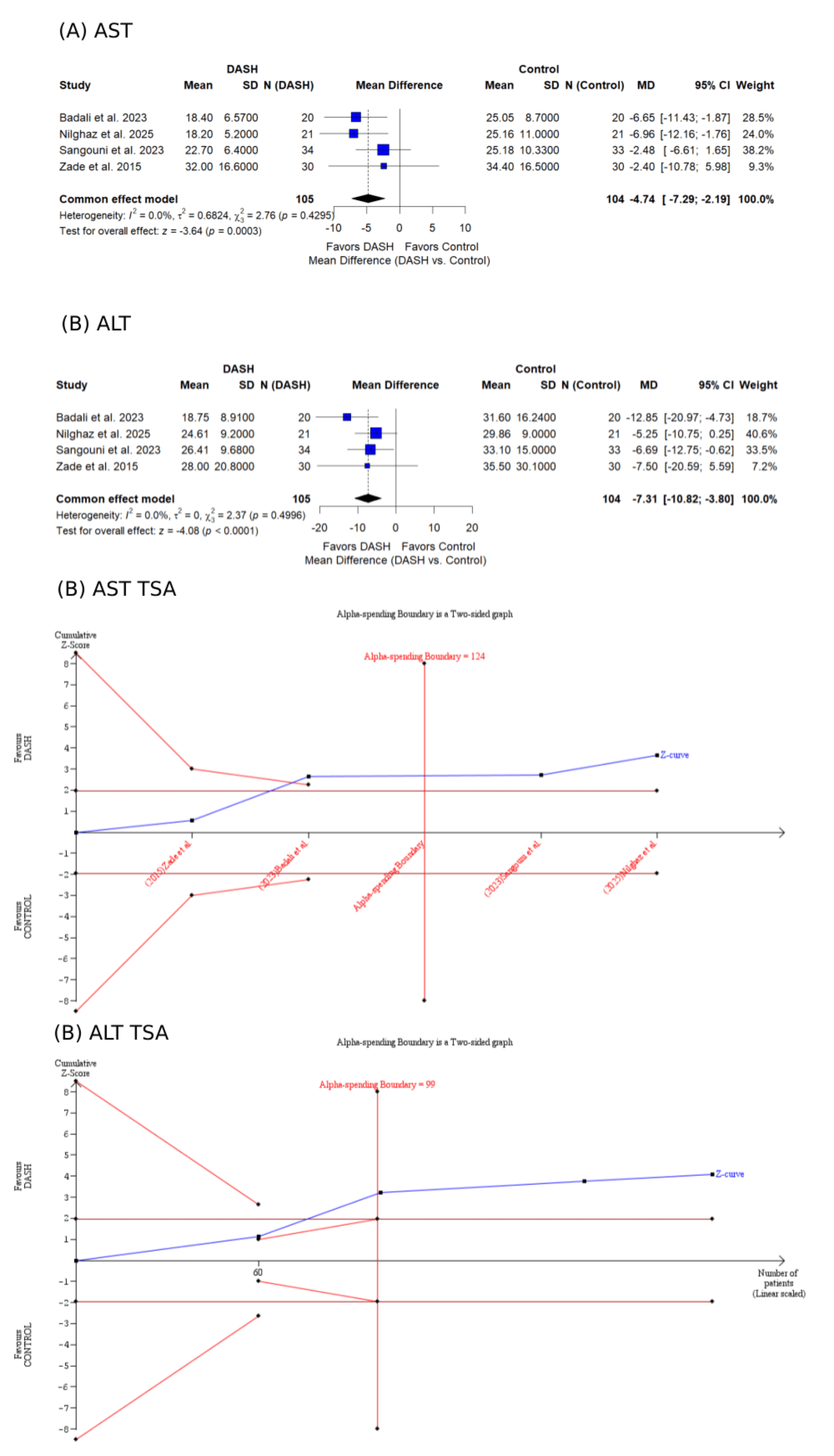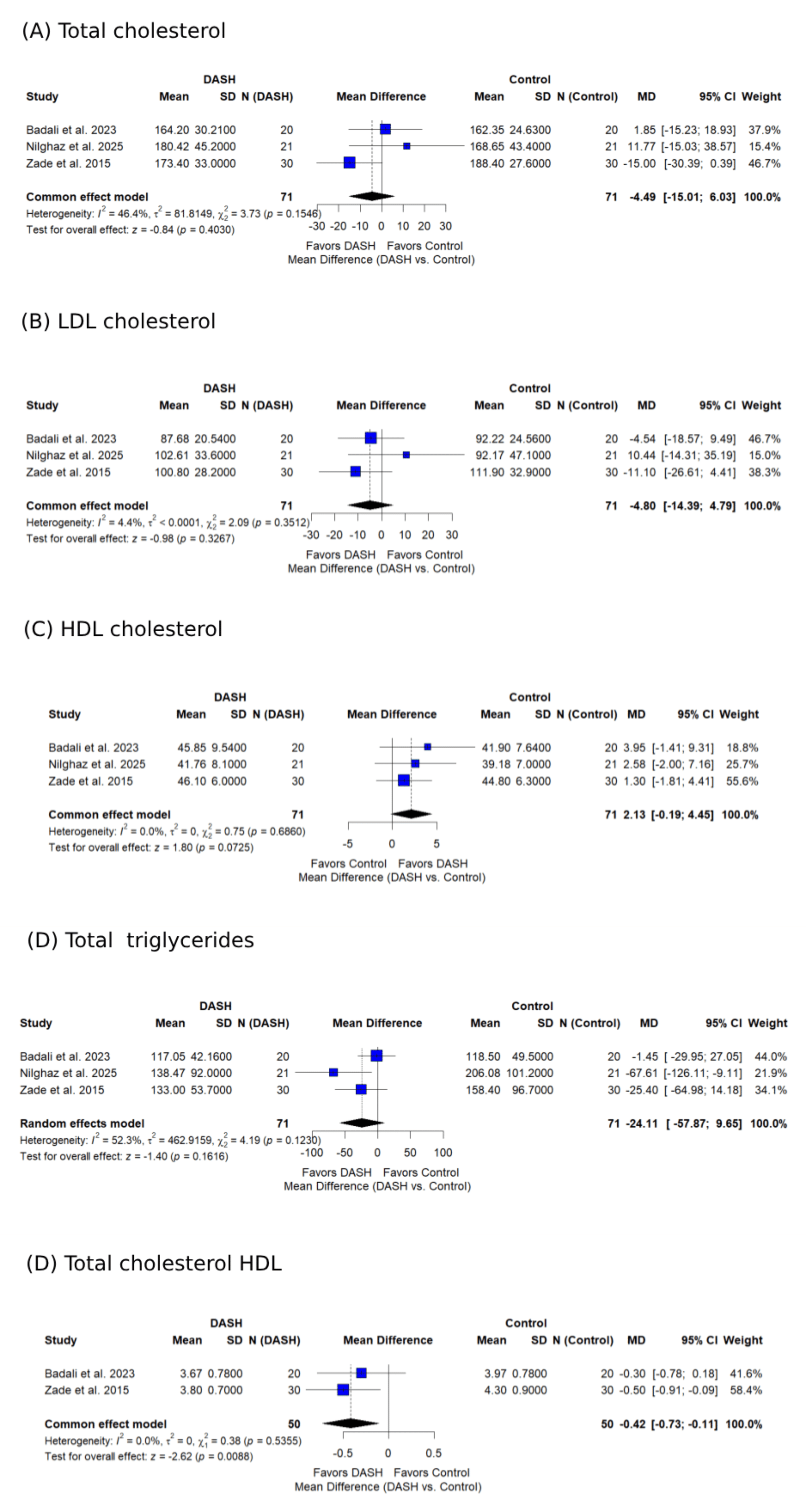Sunday Poster Session
Category: Liver
P1568 - Dietary Approaches to Stop Hypertension (DASH) for Metabolically Associated Liver Steatosis Disease: Systematic Review, Meta-Analysis, and Trial Sequential Analysis
Sunday, October 26, 2025
3:30 PM - 7:00 PM PDT
Location: Exhibit Hall

Ismail Elkhattib, MBBCh
University of Nebraska
Hartford, CT
Presenting Author(s)
Award: ACG Presidential Poster Award
Husam Abu Suilik, MD1, Bashar M. Al Zoubi, MD2, Ibrahim Gowaily, MD3, Mohammad Abu Suilik, MD4, Abdelrahman Awad, MBBCh5, Ahmed Hosney Nada, MBBCh6, Ahmed Farid Gadelmawla, MD7, Ismail Elkhattib, MBBCh8, Mohamed Abuelazm, 9
1The Hashemite University, Zarqa, Az Zarqa', Jordan; 2The Hashemite University, Az Zarqa, 'Amman, Jordan; 3Creighton University Medical Center, Omaha, NE; 4Yarmouk University School of Medicine, Irbid, Irbid, Jordan; 5Mansoura University, Mansoura, Ad Daqahliyah, Egypt; 6Benha University, Benha, Al Qalyubiyah, Egypt; 7Menoufia University, Menoufia, Al Minufiyah, Egypt; 8University of Nebraska, Hartford, CT; 9Faculty of Medicine, Tanta University, Tanta, Egypt, Tanta, Al Gharbiyah, Egypt
Introduction: Metabolic Associated Liver Steatosis Disease (MALSD) is a common metabolic disorder with few non-drug treatments. The Dietary Approaches to Stop Hypertension (DASH) diet, known for heart health, is being studied for its effects on the liver, metabolism, and body measurements in MALSD patients.
Methods: We included randomized controlled trials (RCTs) by searching PubMed, Web of Science, SCOPUS, Cochrane, and Embase through May 10th, 2025. The primary outcome was liver fibrosis. Secondary outcomes included liver enzymes, anthropometric measures, lipid panel, and fasting blood sugar. We pooled dichotomous data using the risk ratio (RR) and continuous data using the mean difference (MD), with a 95% confidence interval (CI). Trial sequential analysis (TSA) was conducted to investigate the robustness of the results. PROSPERO ID: CRD420251060329.
Results: We included five RCTs with a total of 280 patients. DASH diet did not affect liver fibrosis change (MD = -0.51, 95% CI: -1.07 to 0.05; p = 0.0762), patients with grade 0–1 liver fibrosis (RR = 1.37, 95% CI: 0.91 to 2.07; p = 0.13), and grade 2–3 fibrosis (RR = 0.60, 95% CI: 0.35 to 1.03; p = 0.06). The DASH diet significantly reduced alanine aminotransferase (MD = -7.31, 95% CI: -10.82 to -3.80; p < 0.0001) and aspartate aminotransferase (MD = -4.74, 95% CI: -7.29 to -2.19; p = 0.0003). The total cholesterol/HDL ratio improved significantly (MD = -0.42, 95% CI: -0.73 to -0.11; p = 0.01). Still, changes in total cholesterol (p = 0.40), LDL (MD = -4.80, 95% CI: -14.39 to 4.79; p = 0.32), and triglycerides (p = 0.16) were not significant. BMI decreased modestly (MD = -1.32, 95% CI: -3.69 to 1.05; p = 0.03), while weight (p = 0.93), waist circumference (p = 0.93), and fasting blood sugar (p = 0.99) remained unchanged. Trial sequential analysis supported conclusive effects on ALT and AST, while evidence for BMI remained inconclusive.
Discussion: The DASH diet did not improve liver fibrosis but improved liver enzymes and cholesterol/HDL ratio and modestly lowered BMI in MALSD patients, supporting its potential role in liver and metabolic management.

Figure: Results figure (1)

Figure: Results figure (2)
Disclosures:
Husam Abu Suilik indicated no relevant financial relationships.
Bashar M. Al Zoubi indicated no relevant financial relationships.
Ibrahim Gowaily indicated no relevant financial relationships.
Mohammad Abu Suilik indicated no relevant financial relationships.
Abdelrahman Awad indicated no relevant financial relationships.
Ahmed Hosney Nada indicated no relevant financial relationships.
Ahmed Farid Gadelmawla indicated no relevant financial relationships.
Ismail Elkhattib indicated no relevant financial relationships.
Mohamed Abuelazm indicated no relevant financial relationships.
Husam Abu Suilik, MD1, Bashar M. Al Zoubi, MD2, Ibrahim Gowaily, MD3, Mohammad Abu Suilik, MD4, Abdelrahman Awad, MBBCh5, Ahmed Hosney Nada, MBBCh6, Ahmed Farid Gadelmawla, MD7, Ismail Elkhattib, MBBCh8, Mohamed Abuelazm, 9. P1568 - Dietary Approaches to Stop Hypertension (DASH) for Metabolically Associated Liver Steatosis Disease: Systematic Review, Meta-Analysis, and Trial Sequential Analysis, ACG 2025 Annual Scientific Meeting Abstracts. Phoenix, AZ: American College of Gastroenterology.
Husam Abu Suilik, MD1, Bashar M. Al Zoubi, MD2, Ibrahim Gowaily, MD3, Mohammad Abu Suilik, MD4, Abdelrahman Awad, MBBCh5, Ahmed Hosney Nada, MBBCh6, Ahmed Farid Gadelmawla, MD7, Ismail Elkhattib, MBBCh8, Mohamed Abuelazm, 9
1The Hashemite University, Zarqa, Az Zarqa', Jordan; 2The Hashemite University, Az Zarqa, 'Amman, Jordan; 3Creighton University Medical Center, Omaha, NE; 4Yarmouk University School of Medicine, Irbid, Irbid, Jordan; 5Mansoura University, Mansoura, Ad Daqahliyah, Egypt; 6Benha University, Benha, Al Qalyubiyah, Egypt; 7Menoufia University, Menoufia, Al Minufiyah, Egypt; 8University of Nebraska, Hartford, CT; 9Faculty of Medicine, Tanta University, Tanta, Egypt, Tanta, Al Gharbiyah, Egypt
Introduction: Metabolic Associated Liver Steatosis Disease (MALSD) is a common metabolic disorder with few non-drug treatments. The Dietary Approaches to Stop Hypertension (DASH) diet, known for heart health, is being studied for its effects on the liver, metabolism, and body measurements in MALSD patients.
Methods: We included randomized controlled trials (RCTs) by searching PubMed, Web of Science, SCOPUS, Cochrane, and Embase through May 10th, 2025. The primary outcome was liver fibrosis. Secondary outcomes included liver enzymes, anthropometric measures, lipid panel, and fasting blood sugar. We pooled dichotomous data using the risk ratio (RR) and continuous data using the mean difference (MD), with a 95% confidence interval (CI). Trial sequential analysis (TSA) was conducted to investigate the robustness of the results. PROSPERO ID: CRD420251060329.
Results: We included five RCTs with a total of 280 patients. DASH diet did not affect liver fibrosis change (MD = -0.51, 95% CI: -1.07 to 0.05; p = 0.0762), patients with grade 0–1 liver fibrosis (RR = 1.37, 95% CI: 0.91 to 2.07; p = 0.13), and grade 2–3 fibrosis (RR = 0.60, 95% CI: 0.35 to 1.03; p = 0.06). The DASH diet significantly reduced alanine aminotransferase (MD = -7.31, 95% CI: -10.82 to -3.80; p < 0.0001) and aspartate aminotransferase (MD = -4.74, 95% CI: -7.29 to -2.19; p = 0.0003). The total cholesterol/HDL ratio improved significantly (MD = -0.42, 95% CI: -0.73 to -0.11; p = 0.01). Still, changes in total cholesterol (p = 0.40), LDL (MD = -4.80, 95% CI: -14.39 to 4.79; p = 0.32), and triglycerides (p = 0.16) were not significant. BMI decreased modestly (MD = -1.32, 95% CI: -3.69 to 1.05; p = 0.03), while weight (p = 0.93), waist circumference (p = 0.93), and fasting blood sugar (p = 0.99) remained unchanged. Trial sequential analysis supported conclusive effects on ALT and AST, while evidence for BMI remained inconclusive.
Discussion: The DASH diet did not improve liver fibrosis but improved liver enzymes and cholesterol/HDL ratio and modestly lowered BMI in MALSD patients, supporting its potential role in liver and metabolic management.

Figure: Results figure (1)

Figure: Results figure (2)
Disclosures:
Husam Abu Suilik indicated no relevant financial relationships.
Bashar M. Al Zoubi indicated no relevant financial relationships.
Ibrahim Gowaily indicated no relevant financial relationships.
Mohammad Abu Suilik indicated no relevant financial relationships.
Abdelrahman Awad indicated no relevant financial relationships.
Ahmed Hosney Nada indicated no relevant financial relationships.
Ahmed Farid Gadelmawla indicated no relevant financial relationships.
Ismail Elkhattib indicated no relevant financial relationships.
Mohamed Abuelazm indicated no relevant financial relationships.
Husam Abu Suilik, MD1, Bashar M. Al Zoubi, MD2, Ibrahim Gowaily, MD3, Mohammad Abu Suilik, MD4, Abdelrahman Awad, MBBCh5, Ahmed Hosney Nada, MBBCh6, Ahmed Farid Gadelmawla, MD7, Ismail Elkhattib, MBBCh8, Mohamed Abuelazm, 9. P1568 - Dietary Approaches to Stop Hypertension (DASH) for Metabolically Associated Liver Steatosis Disease: Systematic Review, Meta-Analysis, and Trial Sequential Analysis, ACG 2025 Annual Scientific Meeting Abstracts. Phoenix, AZ: American College of Gastroenterology.

